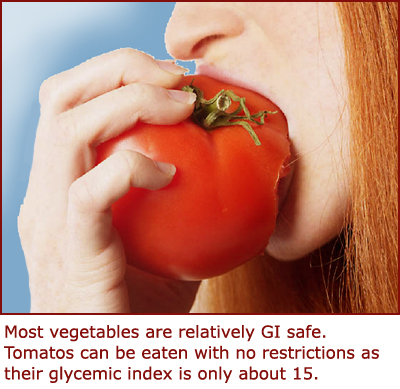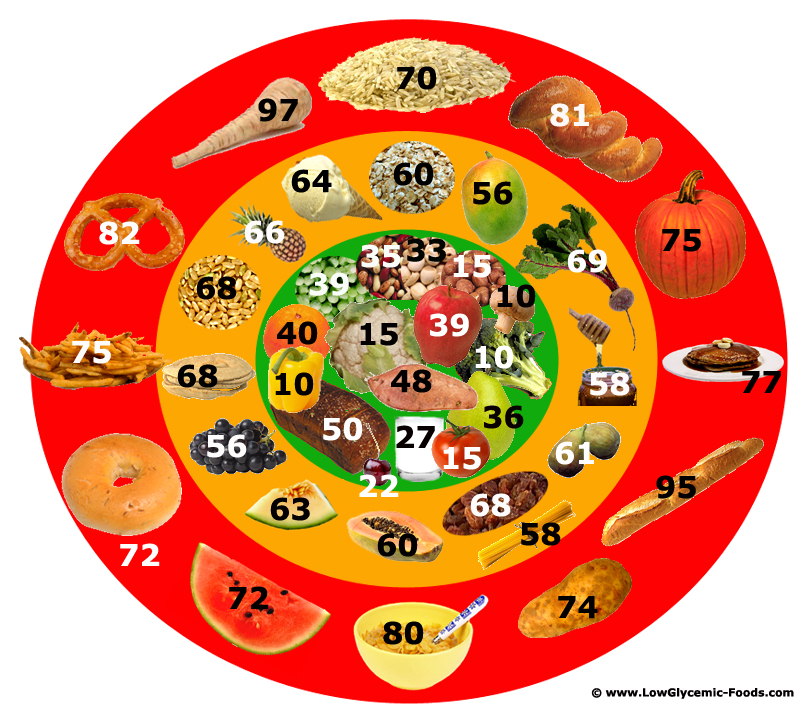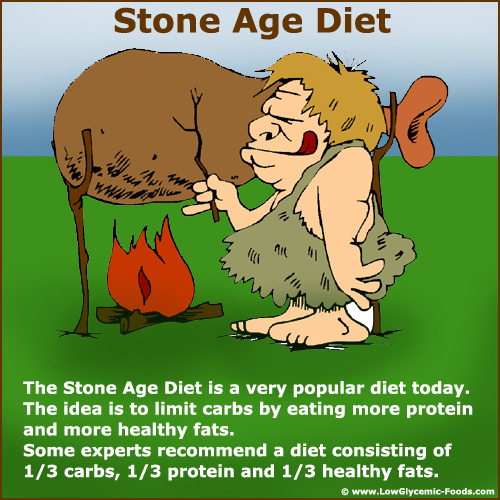The glycemic index food chart is very important, as it will help you to know which foods are to be eaten and which are to be avoided.
The glycemic food index will be your best friend when you try and follow a low glycemic diet, as you’ll be able to scan it to find the foods that you should watch out for if you’re trying to keep your blood sugar under control.
This food chart will contain all of your favorite foods, and you’ll be able to find out which ones are good for your blood sugar levels – thus good for your overall health – and which are bad for your blood sugar levels – thus to be avoided!
Okay your main reason for being here is probably to see this glycemic chart so why don’t go to that first! 🙂
The Glycemic Index Food Chart Model
Here is a brief explanation to help you navigate in the model below:
- The green circle consists of food that are low in the glycemic index 0-55. These types of foods can be eaten in large quantities with little effect on your blood sugar.
- In the orange circle you’ll find foods that are medium GI range 56-69. These middle range GI foods should be eaten with certain moderation
- In the red outer circle you’ll see high glycemic foods of 70-100. These types of food are either best avoided or if the food is rich in vitamins and minerals then eaten in limited quantities.
Paleo vs. Neo Carbs
In the model above, you’ll only see foods that contain carbohydrates – therefore you will not find e.g. meat or eggs as they have very few to no carbs in them.
However, in order to deepen your understanding of carbs, here is a simple way to distinguish between glycemic ‘friendly’ carbs and carbs that should be consumed with moderation.
You see, carbs can been divided into two different categories:
- Paleo Carbs – or Stone Age Diet – These are the carbs that come from foods naturally found on earth, such as fruits, vegetables, nuts, roots and, mushrooms.
Imagine what stone age people would find and eat – then you’ve got a good idea of what paleo carbs are. 🙂
Thus many experts today believe that the Paleo Carbs are the ones that are the best for you to eat, as they are the ones that your body was designed to consume.
- Neo Carbs – Modern Carb Rich Diet – These are the carbs that come from foods resulting from agriculture, such as grains, flours, legumes, dairy and processed foods.
The Neo Carbs are the ones that will have the largest impact on your blood sugar (except for legume which have a low GI), and they are the ones that are best avoided if you’re trying to keep your blood sugar levels under control.
It’s interesting to note that the majority of the healthiest foods on the planet fall into the Paleo Carbs category, as they are naturally found on the Earth without mankind needing to promote their growth.
If you want to keep your blood sugar well-balanced, focus on eating the Paleo Carbs.
Sample Foods – What to Go for and What to Avoid
Here are some sample foods to help you learn more about the glycemic index of foods and your body’s response to them:
Vegetables: ‘Yes … Dig in’
– You Want to Go for Low in Carbs but High in Fiber
 The glycemic index for vegetables tends to be very different, depending on the vegetable. (Although, most are on the lower side on the GI.)
The glycemic index for vegetables tends to be very different, depending on the vegetable. (Although, most are on the lower side on the GI.)
For example, your body’s glycemic response to spinach is very minimal, and the glycemic index of avocadoes is very low thanks to their fat, fiber, and mineral content.
However, potatoes are very rich in starch, and they will have a huge effect on your blood sugar. Raw carrots also turn into glucose very quickly, however, the overall amount of sugar is very low, therefore they are quite safe to eat anyway.
The goal is to find not only the veggies that are low in carbs, but also the ones that are high in fiber – as the fibers cancel out the carbs, clever right! 😉
The lower the ranking on the glycemic index of vegetables, the better!
Fruit: ‘Yes … with a Few Restraints’
– The More Sugar, the Higher the Glycemic Index
 Watermelons have a very high GI ranking of 80, which means the glycemic index of watermelon is higher than is good for you while on a low glycemic diet.
Watermelons have a very high GI ranking of 80, which means the glycemic index of watermelon is higher than is good for you while on a low glycemic diet.
The glycemic index of fruit is also very different depending on the fruit.
You see, the ones with the most sugar aren’t necessarily the ones that have the highest GI ranking.
Cherries, for example, have lots of sugar, but they have a lot of fiber to cancel out the sugar – giving them a GI ranking of just 22.
Your body’s glycemic response to grapes is much lower than the glycemic response to melon, as melons have a much higher GI ranking than grapes – 65 for cantaloupe melon and 46 for grapes.
Grains and Rice: ‘Yes… But Choose Carefully’
– Once Again, You Want, Low Carb, High Fiber
 Some grains contain very few carbs, and they are the ones that you should try and eat as much as possible.
Some grains contain very few carbs, and they are the ones that you should try and eat as much as possible.
Instant oatmeal has a GI of 66, which means that your body’s glycemic response to porridge oats will be more noticeable than its reaction to lower GI foods.
The glycemic index of white is very high, about 70, so it’s quite high on the carbs scale.
Your body’s glycemic response to couscous is also somewhat high, as it has a GI of 61.
You should try and find the grains that have the most fiber, and the lowest amount of carbs – such as quinoa which has a GI of 53.
Alcohol: ‘No… in General, Best Avoided’
– Contains Few Carbs but Lots of Sugar
Alcohol isn’t ranked the same way as the other foods in the glycemic index food chart, as it doesn’t contain a lot of carbohydrates.
However, seeing as alcohol contains a lot of sugar, it is believed that it has a very noticeable effect on your blood sugar levels.
Beer will have a noticeable effect on your blood sugar levels if you drink a lot, though small amounts won’t raise your blood sugar too much.
The glycemic index of wine is hard to measure, but a glass of red wine shouldn’t raise your blood sugar at all.
So all in all, alcohol should be taken with care (as always) while on a low glycemic diet, as it can cause your blood sugar to rise.
Snacks: ‘Depends on the Type’
– Avoid Those With High Starch Content
Your body can handle a certain amount of sugar, but sweets and snacks tend to be much too high on the list of GI foods than is good for you.
You’ll find that the glycemic index of popcorn tends to vary, but suffice it to say that air popped popcorn is always the best for you.
Chips and other salty snacks tend to very high in carbs, so they are also best avoided while on a low carb diet.
Most of the snacks are made with bread, corn flour, potatoes, or white flour, so they will all be made with ingredients that are very high in starch, thus high in the glycemic index.
Nuts: ‘Oh Yes, Definitely’
– Low GI and Rich in Fiber and Good Fats
Nuts are actually a very interesting type of food, as they are rich in fat, rich in fiber, and rich in minerals.
They tend to be very low in the Glycemic Index, and your body’s glycemic response to almonds, peanuts, and other nuts tends to be minimal.
You can usually eat a handful or two of nuts per day, and you’ll be able to fill up without affecting your blood sugar.
However, you do need to keep in mind that nuts are very high in calories and fats, and these nutrients can cause problems if they are consumed in excess.
Candy: ‘No, Don’t Go There’
– Lots of Sugar
Candy is almost always bad for your body, and anyone that wants to be healthy tends to take steps to avoid candy on a regular basis.
Candy has a very high GI ranking, and this is because it’s made almost entirely out of sugar, fat, and other ingredients that will affect your blood sugar.
Your body’s glycemic response to mars bar candies will be noticeable, as they have a GI ranking of 65.
This means that eating the candy bars will be very bad for your health, both in terms of sugar and carbs!
Sweet Drinks: ‘Best Avoided in General’
– Watch out for Sugar Bombs
Everyone loves a sweet drink now and again, and there’s nothing like a glass of something cold and tasty to help you relax at the end of a hot day.
Surprisingly, your body’s glycemic response to chocolate milk tends to be fairly low, as it has a glycemic index of just 50 – a very low GI considering that it’s rich in dairy and sugar.
Your body’s glycemic response to Coca Cola is much more noticeable, as it has a GI of 63. Even the Zero alternatives to the soft drinks – the ones that contain no sugar and no calories – will usually contain sweeteners, and they can cause a visible response in your body. For this reason, it’s best to avoid soft drinks altogether.
Easy Tips to Identify High or Low Glycemic Foods
Here are some things that you need to know about the food in your home and on the glycemic index food chart:
1) White Foods Are Almost Always High Glycemic Foods
It’s interesting to note that most of the white foods on the planet are the ones that are lowest in nutrients plus they tend to be higher in carbs.
White potatoes have a much higher GI value than their yellow cousins, and white radishes are some of the starchiest tubers on the planet.
White flour and white rice have had most of the nutrients bleached out of them, and thus they have the highest impact on your body’s blood sugar levels.
For this reason, it’s wise to be cautious with these white foods.
2) Foods That Are Rich in Fiber Have a Lesser Impact
Net carbs is the concept that explains how the fiber cancels out the carbs in the food you eat.
Say that there is 15 grams of carbs in a plate of fruit, but there is 12 grams of fiber. This means that you’re only getting 3 grams of net carbs, which is very little impact on your body.
The key to being able to eat lots of food without raising your blood sugar levels is to find the foods that have the highest amount of fiber, as the fiber will neutralize the effects of the carbs.
Even some of the foods that have a high GI ranking will have very few net carbs, as they are loaded with fiber – which cancels out the carbs by preventing them from being absorbed into your bloodstream.
3) Protein-Rich Foods Will Usually Be Lower on the Glycemic Index
Foods that have lots of protein tend to be lower in carbs, though that’s not always the case.
They may not have a lot of fiber in them, but they tend to be fairly low in starch and sugar.
Some dairy products have a lot of protein, and they have lactose – a form of sugar that is processed as carbs by your body.
However, meat like chicken, and fish have very few carbs, and they can be a good foundation of your low glycemic diet. The more protein a food has, the more likely it is that it will be on the list of low carb foods.
4) It’s Wise to Keep Fat Consumption Limited, But It’s Not All Bad
The interesting thing about eating fats is that your body has to turn to fat as an energy source when you keep your carb consumption low.
Your body usually burns carbs for energy, as they’re a quick fuel that can be accessed instantly when you need an energy boost. However, fat takes longer to burn, but it will provide a steady burn.
If you’re keeping your carb consumption low, your body will have no choice but to burn fat. If you eat more fat, your body will burn it for energy.
For this reason, most low carb diets call for a lot of fat. However, you need to limit the saturated fats found in red meat and animal proteins.
You should try and get as much unsaturated fat as possible, as this type of fat is much easier for your body to burn.
Unsaturated fats can be found in nuts, fish, olive oil, and legumes, and these are the fats that will promote weight loss and healthy living.
5) Don’t Forget to Eat a Well-Rounded Meal
The way your body is affected by certain foods depends not only on the individual food itself, but also on all of the other food that you eat.
Say you eat a lot of potatoes, which have a fairly high GI value. If you eat lots of fiber, you’ll cancel out a lot of the carbs in the potatoes – and your meal will not have as much of an effect on your body.
This means that eating a well-balanced meal is the key to keeping your carb consumption limited, as you’ll be able to eat foods that will reduce the effect the foods have on your body.
6) Eat Right if You Want to Be Healthy
The key to being healthy is to eat a balanced diet, which means that you’ll need to limit the amount of food that you eat as well as the type of food that you eat.
Your blood sugar can be controlled by the right low glycemic diet, but the fat and cholesterol in your body can get out of control if you eat too much of the wrong type of fat.
The goal of the diet is to improve your health and control your blood sugar levels which is best done by a healthy, balanced, varied and fast carb controlled diet!
Other Pages on This Site, You Might Want to Visit
Guide to a Low Glycemic Diet: Identifying Foods Low in the Glycemic Index & Ruling out the Sugary High GI Traitors
Find the Values of Different Low Glycemic Index Foods and Learn How to Healthily Follow a Low Carb Diet
A Low Glycemic Food List: Identifying the Good Slow Carbs and the Bad Fast Carbs
Glycemic Index Diet Guidelines: Low Glycemic Recipes and Foods
Exercise Glycemic Control by Following the Low Glycemic Index Diet
A Long Glycemic Index Food List to Keep Your Blood Sugar Levels Balanced
A Comprensive Glycemic Index Chart along with a Low Glycemic Food List
Low Glycemic Index Diet Tips: Simple Guidelines to Avoid the Trickery Pitfalls
The Healthy Low Glycemic Foods Diet: How to Eat According to the Glycemic Index
Go to the top of this page about the glycemic index food chart



